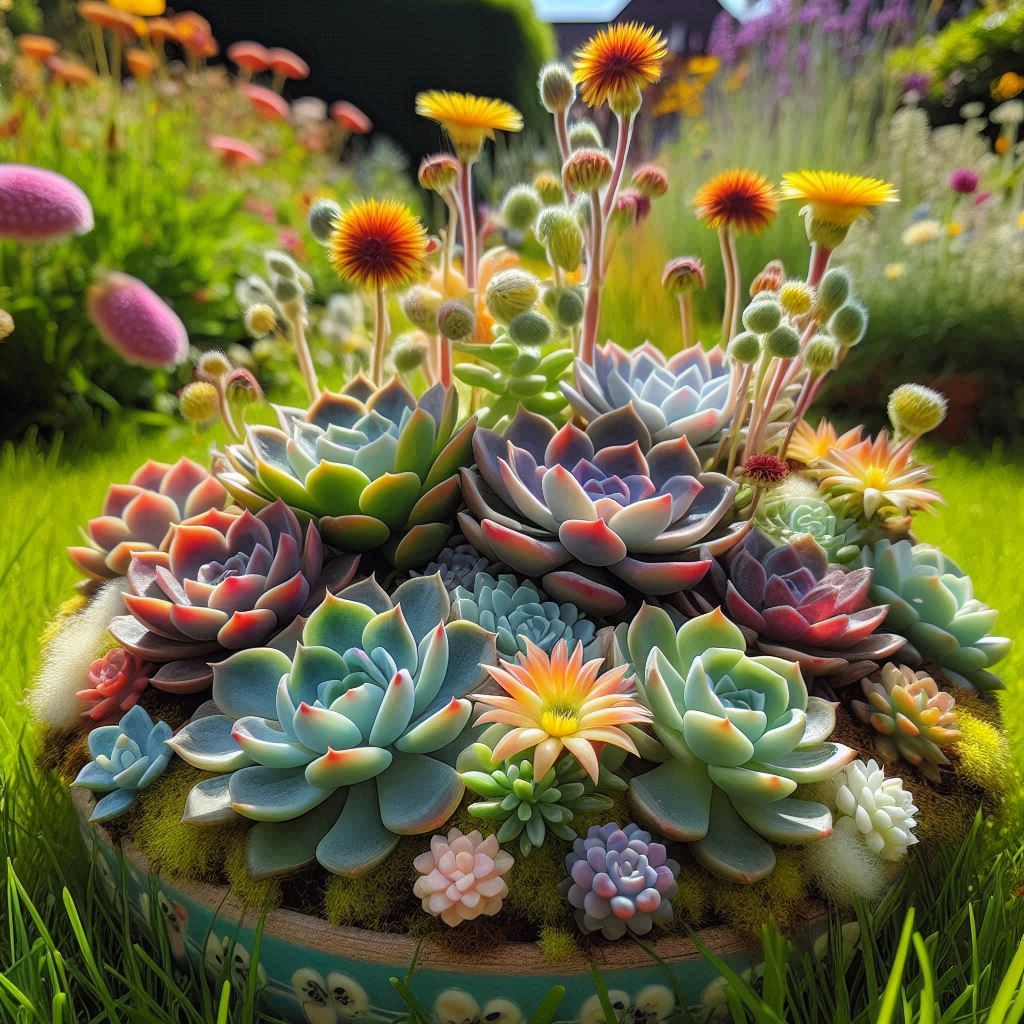Succulents are popular for their hardy nature and versatile beauty. But many plant enthusiasts wonder whether these fleshy friends can thrive outside. With the right conditions and some preparation, succulents can indeed survive—and even flourish—in the great outdoors. This guide will walk you through understanding their resilience, catering to their needs, and ensuring your succulents stay vibrant and healthy outside.
Understanding Succulent Hardiness Zones for Outdoor Growth
Understanding the hardiness zones for succulents is essential for their successful outdoor growth. Hardiness zones are geographic areas defined by climatic conditions, especially the minimum temperatures. Succulents need to be planted in zones that match their tolerance to cold and heat. The U.S. Department of Agriculture (USDA) has designated 13 hardiness zones, which guide gardeners in selecting plants suitable for their area.
Most succulents thrive in zones 9 through 11, where winter is mild, and there’s little to no frost. However, if you live in a colder climate, you may still grow certain cold-hardy varieties like Sempervivum and some Sedums. It’s crucial to consider that even the most cold-tolerant succulents need protection from hard frosts and extended cold periods.
To determine your hardiness zone, check the USDA Plant Hardiness Zone Map, which can provide insights into the temperature ranges your succulents can survive. This ensures that you choose the right plants and plan your garden effectively. With the right preparation and knowledge of your hardiness zone, your outdoor succulents can thrive in the correct conditions, enhancing their survival chances.
Ideal Outdoor Conditions for Succulent Plants
When it comes to growing succulents outdoors, understanding the ideal conditions is crucial. Succulent plants generally thrive in environments that mimic their natural desert habitats. One of the most important factors to consider is the amount of sunlight these plants receive. Succulents typically prefer bright, indirect sunlight, making them perfect candidates for outdoor spaces that receive strong morning sun but are shaded in the afternoon. This helps prevent sunburn, which can occur with prolonged exposure to intense rays.
Another critical aspect of outdoor care is ensuring proper soil drainage. Succulents do not like to sit in wet soil, which can lead to root rot. It’s imperative to plant them in well-draining soil or containers with drainage holes. Opt for soil mixes specifically designed for succulents or cacti.
Climate plays a significant role in determining the appropriateness of outdoor environments for succulents. They usually fare better in warm temperatures but can handle cooler climates with some adjustments. If you live in an area with cold winters, consider moving your succulents indoors or providing proper insulation during the colder months.
Humidity
These plants generally prefer arid conditions with low humidity. Excess moisture in the air can lead to fungal problems and may affect their overall growth. It’s essential to position them in areas where air circulation is ample, reducing the risk of stagnant, humid air.
Lastly, wind is an environmental factor to account for. While succulents benefit from good airflow, strong winds can damage or dehydrate them. Creating a windbreak using taller plants or structures can help protect these delicate plants.
How to Choose the Right Succulent Varieties for Your Climate
When determining the right succulent varieties for your climate, it’s essential to consider local weather conditions. Some succulents thrive in hot, arid places, while others do well in areas with cooler temperatures.
The first step is to check your region’s hardiness zone. This helps you select plants that can withstand minimum winter temperatures typical for your area. Succulents native to deserts like the Agave or Aloe usually prefer warm regions and can handle direct sunlight and drought once mature. In contrast, varieties like Sempervivum, also known as ‘hens and chicks,’ are more cold-tolerant and suitable for areas with a longer winter.
Furthermore, don’t overlook the water requirements. Some succulents like Echeveria require less water and are appropriate for areas where rain is infrequent. On the other hand, Crassula varieties might need slightly more moisture and shade if you’re in an area with harsh sun.
Assessing the amount of sunlight is crucial. Ensure many varieties like Cacti receive ample sunlight for optimal growth. Yet, consider offering some shade during peak heat to prevent possible burns, especially in humid tropical climates.
Lastly, choose robust varieties that can resist potential pests or diseases prevalent in your outdoor environment. Ensuring the right match between the succulent’s needs and your climate will promote a thriving outdoor environment and a vibrant succulent garden.
Preparing Succulents for Outdoor Living: Essential Tips
Transition Your Succulents Gradually
Before moving succulents to their permanent outdoor spot, let them acclimate gradually. Start by placing them in a shaded area to protect from direct sunlight exposure. Over a couple of weeks, slowly increase their time outdoors to help them adjust while avoiding sunburn.
Soil Preparation
The right soil mix is crucial for outdoor succulents. Consider a gritty mix that ensures fast drainage to avoid root rot. A blend of sandy soil, pumice, or perlite will promote excellent drainage. Avoid heavy, clay-rich soils that retain moisture.
Sunlight Needs
Succulents generally enjoy bright light, but too much direct sunlight can cause stress. Observe your plant’s behavior, as changing leaf colors can indicate too much sun. Ideally, position them where they receive indirect sunlight during the hottest part of the day.
Temperature Tolerance
Not all succulents are frost-hardy. In areas with cold winters, research the cold hardiness of your specific succulent to determine if it needs protection. For instance, consider covering them during chilly nights or bringing potted succulents indoors temporarily.
Spacing and Arrangement
When planting succulents outdoors, give them ample space to grow. Adequate spacing ensures airflow between plants, reducing humidity levels and the risk of disease. It also allows for easier access to sunlight, benefiting photosynthesis.
Nutrient Supply
Succulents aren’t heavy feeders, but they require some nutrients. Use a balanced, diluted fertilizer once a month during the growing season. Avoid over-fertilizing, as it can result in weak, overly lush growth prone to pests. Mulching for Protection Applying a thin layer of gravel or pebbles around the base can reduce weed growth and help retain soil moisture. This layer also acts as a protective shield against heavy rains or scorching sunlight.
Monitoring and Maintenance
Regularly check succulents for early signs of distress, like discolored leaves or stunted growth. Adjust care strategies as necessary, whether it is tweaking watering routines, modifying soil, or relocating them to a more suitable environment.
Signs Your Outdoor Succulents Are Thriving
To determine if your outdoor succulents are thriving, pay close attention to their color. Succulents that are healthy will typically have a vibrant, rich hue. The leaves should appear firm and plump, indicating they are retaining the right amount of water. If leaves become mushy or fall off easily, it might suggest overwatering or root rot.
Additionally, observe the growth patterns. A thriving succulent will show signs of growth like new leaves or small offsets. These indicate that the plant is receiving sufficient light and nutrients. Succulents positioned outdoors generally receive ample sunlight, stimulating growth and sometimes giving the leaves a slight reddish or purplish hue, which is normal for some species.
Check the roots if you suspect any issues. Healthy roots are sturdy and spread well within the soil. Conversely, black or mushy roots indicate problems like rot. Well-aerated and dry soil environments foster healthy root systems.
Finally, don’t overlook the pest conditions. A pest-free succulent is often an indicator of good health. Regularly check for any signs of pests like aphids or mealybugs. Addressing pest issues promptly will help maintain your succulents in a thriving state.
Consistently monitor these signs, and you can enjoy flourishing succulents that enhance the beauty of your outdoor space.
How to Protect Succulents from Extreme Weather Outdoors
When succulents face extreme weather conditions, it’s essential to provide them with appropriate protection to ensure their survival. Whether it’s scorching heat, heavy rains, or chilling cold, each type of weather can pose unique challenges.
Shielding from Intense Heat
During very hot days, succulents can become sunburned or dehydrated. A good practice is to provide them with shade using a light cloth or to place them under a canopy. Ensure they have access to enough water without causing root rot.
Protection from Cold Temperatures
Cold weather can be equally damaging. If a frost warning is in place, cover your plants with burlap or frost cloth overnight. In extremely cold regions, consider relocating your succulents to a sheltered area or indoors.
Managing Heavy Rainfall
Excessive water can lead to rot, so it’s crucial to improve drainage. Raise your succulents on a rocky bed or place them in pots where water can easily drain. Ensure the soil is well-draining to prevent water accumulation around the roots.
Wind Barriers
Strong winds can uproot or damage succulents. Consider planting windbreakers like native shrubs or constructing a temporary barrier to shield against heavy gusts.
Mulching and Soil Care
Adding a layer of gravel or mulch can help regulate soil temperature and prevent erosion. It also reduces the impact of heavy rain and increases the longevity of your succulent beds during extreme weather episodes.
By taking these protective measures, you can help ensure your succulents thrive despite the challenges posed by extreme weather conditions outdoors.
Watering Guidelines for Outdoor Succulents
Watering outdoor succulents requires careful attention to their unique needs. Succulents are water-storing plants, adapted to dry, arid climates, which means they can suffer from overwatering. For outdoor succulents, it’s essential to monitor the soil moisture levels regularly. Allow the top inch of soil to dry out completely before watering again.
In general, succulents planted in the ground may need about one deep watering every two weeks, while those in containers could require a bit more frequent watering since they dry out quicker. During hot, dry spells, succulents might need more frequent hydration, but be cautious not to oversaturate the soil.
It’s crucial to water early in the morning or late afternoon, reducing evaporation and giving plants time to absorb the water before the day’s heat. Using well-draining soil is a must, as it helps prevent root rot, a common issue with excessive moisture. Consider raised beds or containers with drainage holes for improved control over water exposure.
Monitor weather conditions regularly, especially during rainy seasons, as outdoor succulents may not require any additional watering. Ensure that the soil beneath your succulents remains well aerated and does not stay soggy for extended periods.
Adjust your watering habits seasonally. During winter, when succulents enter dormancy, reduce watering frequency to avoid fungal infections. Learning the specific needs of your succulent types helps ensure their long-term health and survival outdoors.
Dealing with Pests and Diseases in Outdoor Succulents
Outdoor succulents, while resilient, are not immune to pests and diseases. Common pests like aphids, mealybugs, and snails can cause significant damage to your plants. To tackle these intruders, inspect your succulents regularly and remove pests by hand or use a gentle insecticidal soap. For more persistent infestations, consider introducing natural predators such as ladybugs, which can help keep pest populations in check.
Diseases in succulents usually occur due to poor ventilation or excessive moisture. Any signs of rot, mold, or mildew should be taken seriously. Ensure your succulents have enough air circulation and limit overhead watering to prevent such issues. Trim affected areas with sterilized tools to prevent the spread of diseases.
Maintaining a healthy environment is crucial for preventing pests and diseases. Ensure the soil has proper drainage to avoid root rot, which is a common issue due to overwatering. It’s helpful to use a well-draining succulent soil mix and avoid using heavy, clay-based soils.
Consider using preventative measures such as neem oil, which can deter pests and act as a fungicide. These small proactive steps will help keep your outdoor succulents healthy and thriving. Consistent monitoring and maintenance can significantly reduce the chances of infestations and diseases becoming a serious problem.
Soil Requirements for Growing Succulents Outside

Adding the right soil is crucial for the health and growth of succulents when planted outside, especially when considering the question: can succulent plants survive outdoors? The answer often lies in the soil composition. These plants thrive in well-draining soil, which helps reduce the risk of root rot, a common issue with succulents in poor soil conditions.
Use a Gritty Mix:
To improve drainage, amend the soil by incorporating gritty materials like sand, pumice, or perlite. A balanced blend typically includes about 50% potting soil, 25% sand, and 25% pumice or perlite, which provides the ideal environment for succulents to flourish outdoors.
Avoid Heavy Soils:
Heavy, clay-based soils retain too much water, which can cause poor drainage and lead to rot. If your garden soil is dense, consider raising the beds or using containers to improve the environment for outdoor succulents.
Consider Soil Acidity:
While succulents are fairly resilient, they perform best in slightly acidic to neutral soil with a pH around 6.0 to 7.0.
Test the Drainage:
Before planting succulents outdoors, check the soil’s drainage. Dig a hole, fill it with water, and observe how quickly it drains. If the water disappears within an hour, the soil should be suitable for succulents, ensuring they thrive in outdoor conditions.
Include Organic Matter: While succulents don’t need overly rich soil, a small amount of compost can provide vital nutrients without compromising drainage.
Regularly Refresh the Soil: Over time, outdoor soil can become compacted or depleted of nutrients. Refreshing the soil mix every couple of years will keep it aerated and nutrient-rich, supporting the health of your succulents.
Using Containers vs. Direct Planting for Outdoor Succulents
When deciding whether to use containers or direct planting for outdoor succulents, several factors come into play. Containers offer flexibility, allowing you to move succulents to sheltered areas during extreme weather conditions. This is particularly advantageous in regions that experience harsh winters or intense summer heat, ensuring the plants are not exposed to conditions beyond their tolerance.
On the other hand, direct planting into the ground can be beneficial for succulents as it allows the roots to expand naturally and access nutrients more easily. This method often results in more robust growth, provided that the climate and soil conditions are suitable.
When using containers, opt for materials that provide good insulation and ensure that the pots have adequate drainage holes. Poor drainage can lead to waterlogged soil, which is detrimental to succulent health. Additionally, choosing the right potting mix is crucial for container planting, as succulents require soil that allows quick drainage to prevent root rot.
For direct planting, ensure that the ground soil mimics the character of commercial cactus mixes, which typically comprise a combination of sand, perlite, and gravel. Raising the garden bed or creating a rock garden can enhance drainage and contribute to a thriving succulent landscape.
Ultimately, understanding your local climate and the specific needs of your succulent species will guide you in choosing between containers and direct planting. Both methods have their merits, and sometimes a combination suits best, providing the aesthetic appeal and protection required for a flourishing outdoor succulent array.
How to Create a Succulent Garden in Your Yard
Transforming your yard into a magnificent succulent garden is a rewarding venture. Begin by selecting an area that receives ample sunlight, as most succulents thrive with a lot of direct sunlight. Consider creating different zones for varying types of succulents that might prefer slightly different conditions.
Next, focus on the soil. Succulents require well-drained soil, so you might need to amend your garden bed with sand or gravel to ensure proper drainage. Raised beds can also be a beneficial feature to prevent root rot.
Plan the layout by grouping succulents of similar care requirements together. Use contrasts in height, color, and texture to create visual interest. For instance, pair taller succulents with sprawling types for a dynamic appearance.
Incorporate hardscaping elements like stones or pebbles to enhance aesthetics and mimic a desert-like environment. These features can also help retain heat and provide a natural habitat feel.
Maintenance is crucial; remove dead leaves and ensure your plants don’t become overcrowded. Regularly check for signs of pests and address them promptly. With attention and care, your succulent garden will flourish and become a beautiful outdoor retreat.
Common Mistakes to Avoid When Growing Succulents Outdoors
Growing succulents outdoors can be rewarding, but it’s easy to make mistakes that can hinder their growth. One common mistake is overwatering. Succulents are drought-tolerant and thrive with minimal water, so too much water can lead to root rot. Ensure you only water when the soil is completely dry.
Another pitfall is planting in the wrong soil. Regular garden soil is too heavy for succulents, as it retains too much moisture. Using a well-draining mix specifically designed for succulents prevents water retention and root issues. A common question is, can succulent plants survive outdoors? The answer depends largely on the climate. Understanding your region’s hardiness zone is crucial, as some succulents can tolerate cold, while others cannot survive frost.
Additionally, don’t forget about sun exposure. While most succulents prefer bright light, direct intense sunlight can scorch them. It’s important to gradually acclimate them to the outdoor sun to avoid sunburn.
Improper spacing is another error. Succulents need space to grow and air circulation to prevent disease. Crowding them can lead to mold and pest infestations.
Avoid using fertilizers excessively. While they can promote growth, too much can harm your plants. Opt for a balanced fertilizer during their growing season, but use sparingly.
Not taking precautions against extreme weather is a common misstep. Ensure you have strategies in place for protecting your succulents from unpredictable weather like frost or heavy rain to keep them healthy.
When you take your succulent plants outdoors, understanding their specific hardiness zones is crucial. But can succulent plants survive outdoors? The answer depends on the variety and the climate conditions of your region. Each succulent variety thrives at different temperature ranges, and planting them in the correct zone ensures their survival and growth. Hardiness zones help gardeners identify which plants are likely to thrive at a location’s average climate conditions.
Most succulents do well in USDA zones 9 to 11, where temperatures rarely drop below freezing. However, some varieties, like Sempervivum and certain Sedum, are colder-tolerant and can survive in zones as low as 3. Knowing your region’s zone will guide you in selecting the right succulents to plant outdoors.
In addition to understanding hardiness zones, consider microclimates in your garden. Areas near walls that receive reflected heat or near bodies of water that moderate temperatures could provide favorable environments even for borderline hardy succulents. It’s wise to choose varieties that align best with these subtleties for optimal outdoor growth.







